RESERVE NOW!
DETAILED
ITINERARY
Day
1 Hometown-Haines, Alaska
Day in transit from hometown to Haines. After disembarking from
your flight to Juneau, you can fly to Haines on a local air flying
service. Your remarkable flight will take you up the Lynn Canal
with spectacular glaciers flanking both sides of our airplane.
You may even see mountain goats scrambling along the knife-edged
ridges. We will all meet in the lobby of the Halsingland Hotel
in Haines at 6:00 PM and have dinner together. Afterwards, we'll
have an orientation session, discuss logistics for the trip, hand
out waterproof bags and ammo cans (for cameras), go over our personal
gear, and answer any questions. (Lodging-dbl occ. and dinner are included).
Day 2 Haines-Dalton Post (Shawshe)-Arctic
Dryas
Camp
After breakfast, we'll have time to make some final purchases
of equipment, and then take a van ride 103 miles over the coastal
mountains into the Yukon to Dalton Post. We go through immigration
and then proceed to Dalton Post, have lunch, load the boats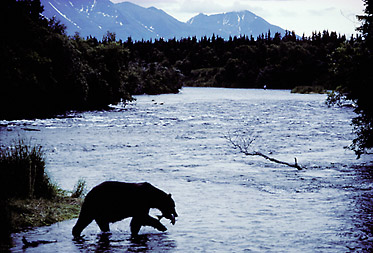 , learn
about river touring and techniques, and shove off on our spirited
river.
, learn
about river touring and techniques, and shove off on our spirited
river.
The
Tatshenshiniis small here, and we glide past black spruce, aspen,
birch and poplar. Numerous bald eagles glide overhead and omnipresent
ravens chortle from spruce boughs. A steep slate canyon and resounding
white-water provide an exhilarating touch to our first river day.
We camp on a glacial flood plain, sit around a blazing fire, and
recount the experiences of the day. (Breakfast on your own)
Day
3 Arctic Dryas Camp to Wildflower Camp
After breakfast, we'll take a short hike and gain insight into
the unique plant and animal communities of the area. The morning
paddle takes us through rich, dense, deciduous woodlands. It is
usually in these secretive woods and serene sections of river
that beaver and moose sightings are made. At lunch, we will find
innumerable tracks of moose, deer, bear, and wolf on the mud flats.
The river valley widens and the mountains rise. Soon the spruce
forests begin to dominate the terrain and our first glaciers are
seen in the distance as we begin cutting through the Alsek Range.
At lunch we have an opportunity to appreciate the wildflowers
growing on the riverbanks and review the wildlife spotted that
morning. In the afternoon, the river picks up speed and we begin
to dance among the braided channels. We camp at Sediment Creek.
Day 4 Wildflower Camp
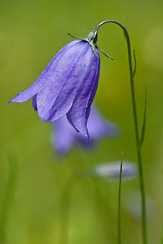 A layover day. We will take a long nature walk and individual
and group photographic instruction will be available. The cobbled
stones of the mile-wide alluvial fan reveal colorful sedimentary
rocks amidst the Arctic Dryas. We will then climb to a meadow
of wildflowers. Most individuals stop here, but some, may want
to climb to the high alpine tundra for views of unnamed peaks,
glimpses of mountain goats clinging to the airy heights, or chance
encounters with marmots and fox.
A layover day. We will take a long nature walk and individual
and group photographic instruction will be available. The cobbled
stones of the mile-wide alluvial fan reveal colorful sedimentary
rocks amidst the Arctic Dryas. We will then climb to a meadow
of wildflowers. Most individuals stop here, but some, may want
to climb to the high alpine tundra for views of unnamed peaks,
glimpses of mountain goats clinging to the airy heights, or chance
encounters with marmots and fox.
Day
5 Wildflower Camp-"The Braids"
We maneuver downstream to another powerful tributary that resounds
with the cacophonous tumbling of rocks in a valley of knife-edged
cliffs. We have lunch here and take a short walk up this old glaciated
valley. Jumping back into the boats, we find that the river's
pace has suddenly increased from 4-6 MPH and we remain constantly
alert and responsive to the braiding of the river channels and
its mesmerizing backlit qualities. If we are fortunate, we may
be able to see Alaskan brown bears on the river bars. We make
camp "in the braids", just downstream of the O'Connor
River. An eagle's nest is perched on a rocky outcropping behind
our camp and dramatic views are to be absorbed in all directions.
A short hike behind camp takes us to a lake dammed by beavers
and enhanced by the presence of a resident pair of Trumpeter Swans.
Day
6 "The Braids"- Center of the World Camp
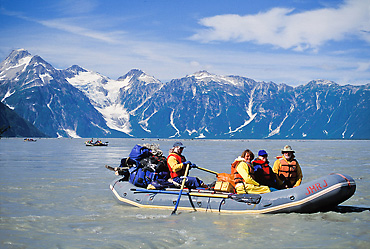 As we spin and whorl downstream, we gain glimpses of the Grand
Pacific Glacier and other snowy peaks in the distance. On a perfectly
clear day, one can see 18 distinct glaciers during this stretch
of river. After
lunch, we glide by countless glacial streams that join the Tatshenshini
and resound with the roar of tumbling boulders. And then, we're
suddenly plummeted into a densely overgrown canyon. Adrenaline
runs high as we move around huge thumping waves. In the distance,
one can see another range of towering glaciers amid the St. Elias
Mountains. After loading up with our evening's supply of firewood,
we arrive at our camp in the center of immense ice-capped mountains
that resemble Pakistan on one side of the river, and Hawaii's
lush Nepali coast on the other. The confluence with the Alsek
is just downstream and the campsite evokes powerful images. In
all directions are breathtaking glaciers.
As we spin and whorl downstream, we gain glimpses of the Grand
Pacific Glacier and other snowy peaks in the distance. On a perfectly
clear day, one can see 18 distinct glaciers during this stretch
of river. After
lunch, we glide by countless glacial streams that join the Tatshenshini
and resound with the roar of tumbling boulders. And then, we're
suddenly plummeted into a densely overgrown canyon. Adrenaline
runs high as we move around huge thumping waves. In the distance,
one can see another range of towering glaciers amid the St. Elias
Mountains. After loading up with our evening's supply of firewood,
we arrive at our camp in the center of immense ice-capped mountains
that resemble Pakistan on one side of the river, and Hawaii's
lush Nepali coast on the other. The confluence with the Alsek
is just downstream and the campsite evokes powerful images. In
all directions are breathtaking glaciers.
Day 7 Center of the World Camp
Layover day. This is one of the finest places for doing nature
photography (both close-up and scenic), taking a brisk hike, or
catching up with your bathing, your diary and Alaskan reading
material. Some individuals have also been known to just sit on
their solar-powered lounge chairs, enjoy the spectacular views,
and rotate with the sun.
Day
8 Center of the World Camp-Walker Glacier
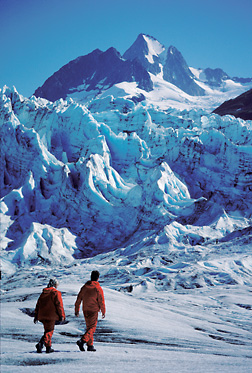 We pass the confluence of the Alsek and the Tatshenshini, an enormous
river whose anomalous crossing of the St. Elias Mountains puzzles
geologists. We pass by ice at river level. High above us, the
steep mountains provide the conditions necessary for the largest
icefields outside of Greenland and the Antarctic ice caps. The
air cools, and the river water temperature is nearly freezing.
We'll set up camp at the foot of the emerald-colored Walker glacier.After
an afternoon snack, we'll hike up onto the glacier peer into deep
blue crevasses and share terrific views in all directions. We'll
discuss glacier terminology and actually feel and hear the glacial
movement beneath our feet. The complex designs of glacial erratics
provide inspiring material for nature photographers. In the evening,
we share the poems of Robert Service, Jack London, Gary Snyder,
Nora and Dick Dauenhauer and tales of the North. In the background,
slow-melting
We pass the confluence of the Alsek and the Tatshenshini, an enormous
river whose anomalous crossing of the St. Elias Mountains puzzles
geologists. We pass by ice at river level. High above us, the
steep mountains provide the conditions necessary for the largest
icefields outside of Greenland and the Antarctic ice caps. The
air cools, and the river water temperature is nearly freezing.
We'll set up camp at the foot of the emerald-colored Walker glacier.After
an afternoon snack, we'll hike up onto the glacier peer into deep
blue crevasses and share terrific views in all directions. We'll
discuss glacier terminology and actually feel and hear the glacial
movement beneath our feet. The complex designs of glacial erratics
provide inspiring material for nature photographers. In the evening,
we share the poems of Robert Service, Jack London, Gary Snyder,
Nora and Dick Dauenhauer and tales of the North. In the background,
slow-melting
glaciers crackle and groan in the distance.
Day
9 Walker Glacier-Alsek Spit
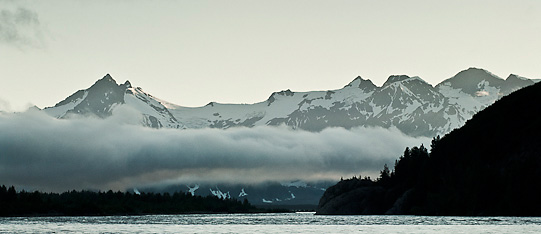
Drifting down an avenue of glaciers with nearly two dozen rivers
of ice in sight at one time, the scenery is overwhelming and small
talk amongst us seems inappropriate. If the day is clear, we'll
have terrific views of Mt. Fairweather and the Alsek Glacier as
we head toward our camp. Late afternoon brings us to a sandy peninsula
separating the river from a bay carved by the retreating Alsek
glacier. The afternoon will be devoted to scenic and macro-flower
photography, and hiking on the nearly level terrain.
Days
10-11 Alsek Lake
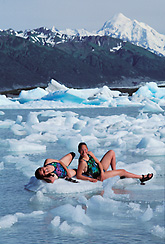
These days are designed for rest and exploration. The wildflower
fields and rock gardens are incredible, but seem insignificant
compared to the floating wonders of the iceberg-filled bay. Loud
crashing booms from the five-mile-wide glacier attest to the calving
of another mammoth iceberg that has been calved from the 200-foot
high face of the glacier. If the bergs are lined up properly,
we'll enter Alsek Lake and drift among them enroute to our camp.
Photographic opportunities abound as we gingerly row by these
colossal house-sized ice sculptures. We'll take a river sauna,
cool off in Alsek Lake, have a triumphal feast, and read Tlingit
Oratory into the early evening.
Day
12 Alsek Lake-Dry Bay-Yakutat-Juneau
With views of Mt. Fairweather and the Alsek Glacier in the background,
we sneak past icebergs and through ice flotsam. For the last eleven
miles, the "bergs" accompany us on our journey to the
ocean. Nearing the coast, the mountainsides become green once
more, as the region is too mild to support ice. We catch our slough,
float into Dry Bay, disembark and then board our small planes,
which will take us back to Yakutat.On
the short flight, we can sometimes observe schooling salmon at
the river mouths, moose feeding placidly in small ponds, and a
rare Alaskan brown bear family out on a stroll. A few hours later,
we board an Alaska Airlines jet back to Juneau. This flight gives
us a glimpse upriver along the Alsek, the awesome glaciers below,
and we revel in one of the most visually rewarding river trips
imaginable. We arrive at the Juneau Airport and transfer to your hotel.
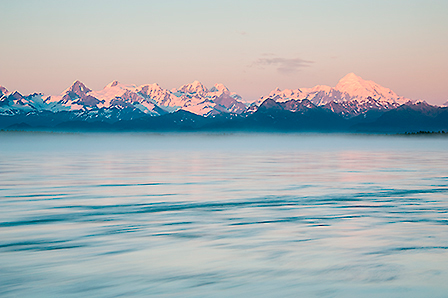
Day After the trip: Juneau-Hometown
Van transportation to the Juneau airport, board Alaska Airline
flight(s) to Seattle, and then transfer to homebound flights.
GENERAL
INFORMATION
COSTS
AND RESERVATIONS:
Costs are based on sharing a double room in Haines and double occupancy in a tent.
Land Cost: $7950 (Includes all park fees and taxes)
LAND
COST:
12-day departures:
June 22-July 3, 2025
July 10-21, 2025
June 27-Aug 7, 2025
Aug 12-23, 2025
Aug 31-Sept 11
MAXIMUM
NO. OF PARTICIPANTS: 11 on Trips #1,#2,#3,#4, #5 departures.
LAND
COST INCLUDES:
*Lodging at the Halsingland Hotel in Haines, Alaska on Day 1 (approx: $250/dbl occupancy)
*Van transportation to our put-in point on Day 1
*Eleven days of wilderness rafting (lifejackets, waterproof bags, tents (double occupancy); all meals from dinner on Day 1 in Haines; Breakfast in Haines on Day 2; on river from lunch
at the put-in on Day 2 of the itinerary through lunch on Day 12 in Dry Bay.
*All campiing gear: including spacious mountaineering tents, cots, pads, and sleeping bags (if needed).
*Licensed guides
*Small plane charter from the take-out at Dry Bay, Alaska to Yakutat, Alaska on Day 12
*Transfer from Juneau Airport to Hotel on Day 12
*Scheduled transfers from hotel to Juneau airport on Day 13
*National Park Service Franchise Fees and BC user day fees.
LAND
COST DOES NOT INCLUDE:
*Roundtrip airfare from hometown to Juneau, Alaska
*Airfare or fare for ferry from Juneau to Haines (approximately
$115-$125 for flight and $40 for ferries)
*Alaska Airline flight from Yakutat to Juneau on Day 12 (approx. $156.00 inc. taxes)
*Lodging in Juneau, Alaska, on Day 12 (appprox. $120/single or dbl. occupancy)
*Single supplement fee Haines only ($250/person).
*Personal camping equipment (sleeping bag, pads, and clothing)
*Items such as liquor, laundry, phone calls, etc.
*Any additional hotel nights due to inclement weather or changes
in airline scheduling
*Meals in Haines, Yakutat, and Juneau (dinner and breakfast in Juneau are on your own).
Plan on $15.00-$20 for breakfasts and $25-$40 for dinners.
*Accident/baggage/trip cancellation insurance. approx.$415/person
*Gratuities to guides
AIR TICKETING
Although we do not do ticketing ourselves, our staff is experienced in advising which flights are best for your departure and we will be happy to disseminate information that will help you with your air ticketing. We strongly advise arriving in Juneau one-day early.
ACCOMMODATIONS: SINGLE SUPPLEMENT
The land cost of the trip includes hotel accommodations based
on double occupancy in Haines. Those individuals who request a single supplement
for hotel accommodations in Haines must pay the Single Supplement
Fee.
Single
Supplement-hotels in Haines only: $250 - no single tents are available.
All of our trips that include in the land cost hotel and tent
accommodations are based on double occupancy. If you are traveling
alone and do not want to be paired with a tentmate, we suggest
that you bring your own tent. (See detailed equipment list for
suggested tents).
ACCOMMODATIONS
FOR SINGLE TRAVELERS WHO WISH TO SHARE
The land cost of the trip includes hotel and tent accommodations
based on double occupancy. If you are traveling alone and desire
a roommate, we will match you up with someone of the same gender, if one is available.
If there is no one with whom you can share accommodations, you
will have to pay the Single Supplement Fee of $65.
REGISTRATION
A deposit of $1000 per person sent in with the registration card
to James Henry River Journeys will reserve your place on the trip.
Final payment is payable three months prior to departure.
Please refer to Booking Information in the current catalog.
TRAVEL
LOGISTICS
There are many options for getting to Haines, Alaska: one may
either fly to Juneau from your hometown, take the Alaska Marine
Ferry from Bellingham, Washington, or drive. More detailed travel
logistics are mailed out upon registration. If you choose to make
your own travel plans, please contact our office and let us know
when and how you will be meeting us after your travel arrangements
have been made.
THE
OUTFITTER
The trips will be conducted by an James Henry River Journeys' affiliate outfitter, Momentum Alaska who
is a concessionaire of Glacier Bay National Park and Preserve
in Alaska and a permit holder of the Tatshenshini-Alsek Provincial
Park. Momentum Alaska is an equal opportunity service
provider.
LEADERSHIP
The Tatshenshini-Alsek River expeditions are led by by the veteran guides of Momentum River Expeditions.
FACULTY
FOR THE TRIP
On all departures the guides facilitate by leading adventurous hikes on layover days and spinning tales of the North country around the campfire.
*Note that if there are any changes in faculty, you can get the latest updates by going to our website and referring to Special Trips or Guides and Facilitators.
WILDERNESS EXPERIENCE, CAMPING LOGISTICS, QUALIFICATIONS, &
PERSONAL CHALLENGES
The Tatshenshini and Alsek Rivers of the Yukon Territory,
British Columbia and Southeast Alaska are undammed and glacially
fed. The Tatshenshini-Alsek has the distinction of offering both
exhilarating Class III+ (intermediate to advanced-intermediate)
rapids alternating with a 5-7 MPH current.
At
our put-in at Dalton Post, flows are usually around 1,000-3,000
c.f.s. (cubic feet/second). As we move downstream and other tributaries
kick in additional water, the river increases tremendously in
volume. After the Alsek conflues with the Tatshenshini, the flows
may vary from 100,000 to 750,000 c.f.s. The
upper part of the river has challenging Class III-III+ (intermediate
to advanced intermediate) rapids that are continuous for 8 miles.
Our June trips experience higher water (the snowmelt) in the upper
stretches of the river while our July and August trips will usually
have lower water in the upper section but increased flows (due
to the secondary glacial melt) in the braided lower sections of
the river. One of the most unique attractions of this river is
that it is ceaselessly changing. Due
to the river's speed we are usually able to have unhurried days
and spend, on an average, little more than four to five hours
on the river each day. Due to our North latitude and the available
light on hand, trip participants will have a great deal of time
for optional hikes, photography, journal writing, and sketching. River
running is mildly strenuous to strenuous in a paddleboat and easy
to mildly strenuous if assisting the oarsman in a paddle-assisted
oarboat. On layover days, we will be hiking up onto ridges above
the river and walking on glacial morraines. The hiking is as strenuous
as you desire and often our groups break up into three-four hiking
groups. The crewmembers lead most of the hiking forays and one
can find the right pace for one's inclinations.Since
this a total wilderness experience, the group will be entirely
self-sufficient. We will carry all our food, cooking gear, clothes,
tents, and sleeping bags in the boats.
The Tatshenshini and Alsek Rivers is a challenging trip and although
exuberance increases with each passing day, this trip is a true
adventure. Therefore, to derive the greatest pleasure from this
trip, one should have a sense of humor, a flexible personality,
and an open and curious mind. We welcome individuals who are 14
years of age or older (please consult with us if your child is
less than 14) who want to partake in the spirit of a true adventure,
sharing with others the joys of wilderness living and river travel. Please
note that our day to day itinerary on the river is flexible, and
will depend upon river levels, weather, and the inclination of
participants. The itinerary, as published, is not literal and
the number of layover days, river days, and campsites utilized
vary slightly from trip to trip. The total trip will remain the
same. Final determination of the river itinerary is made by the
trip leader.
CLIMATE
AND WEATHER
We have planned these trips for late June through mid-September,
as they are the most temperate months in Southeastern Alaska.
It is usually warm-approaching 60-70 degrees and sunny. However,
there is always the possibility of rain on the trip. One should
also note that the famous Alaskan mosquito has little presence
on a river which has little standing water and strong breezes.
FOOD
Fresh food will be available at all meals with international camp
cookery filling the whetted appetites. Our Meals are incomparable!
See Meals.
MEDICAL AND HEALTH INFORMATION
Momentum Alaska will have a complete first-aid kit and carries a SAT phone for emergencies.
Good health and good physical condition are prerequisites
for this trip. Participants will be sent a medical history questionnaire to be signed by you and to be signed by your physician if you are 65 or older or have a medical condition that would require an examination and approval by your doctor prior to your departure. People who are not in good health or have serious chronic pre-existing medical conditions, could potentially create unfortunate situations by being present and are not encouraged to join this type of journey. When in doubt about one’s ability, please consult with our office; if in doubt about your medical condition, please consult with your primary-care physician before signing up.
See Medical
and Health details.
EQUIPMENT: WHAT JAMES HENRY RIVER JOURNEYS
PROVIDES
On each trip there are from two to five boats, with a high participant
to guide ratio of three and occasionally, four to one. We row all of the gear in 18-foot and 16-foot
Avons. We provide paddles for participants in
all the oar boats and one can assist the guide who is rowing the
boat.
We
will be supplying Northface VE-25" 2-person tents
(based on double occupancy) on this trip. If you are traveling
alone and prefer to bring your own tent, you may do so. See What Equipment JHRJ Provides.
PERSONAL
EQUIPMENT
A complete equipment checklist will be sent to all trip members
upon registration.
Warm garments, completely waterproof raingear, and above the mid-calf
rubber boots are necessary for a truly enjoyable experience. Sleeping
bags, pads, rain gear, rubber boots, and daypacks are to be provided
by participants.
PHOTOGRAPHY
The Tatshenshini-Alsek offers the photographer a tremendous opportunity
to photograph some of the most spectacular snow-clad mountain
vistas, cascades, sculpted ice flows, wildflowers, and rock formations
in Alaska. If we are extremely fortunate, we may be able to grab
shots of bald eagles or a grizzly family standing on its haunches
as we shoot by on our rafts.
FISHING
In July-August, the Chinook, sockeye, and Coho salmon are running
upstream, but usually the river is laden with silt and consequently
poor for fishing. It is also very important that as many salmon
as possible make it to their upstream spawning grounds in order
to sustain the numbers of “wild salmon” in the watershed.
In accordance with this philosophy, National Park Service regulations
disallow fishing for salmon along the Alsek River within Glacier
Bay National Park by river outfitters and their trip particpants.
CANCELLATIONS AND REFUNDS
(See Cancellations-Terms
and Conditions)
INSURANCE
(See Insurance-Terms
and Conditions)
To read more about our Special-Interest Trips on this river, go
to Tatshenshini-Alsek Special
Trips.
Return to Tatshenshini Trip Profile.
© 2011. All Rights Reserved. Revised Oct, 2024
James Henry River Journeys.
